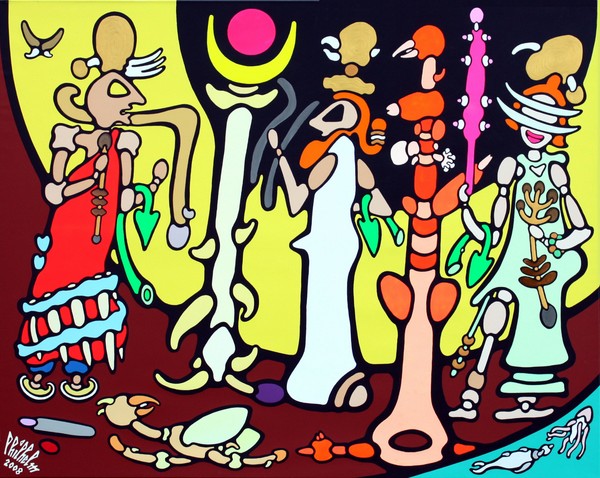- Philhelm PHILHELM
- View Portfolio
- Image 13 of 17
- Added 21 Jan 2012
- 55 Views
- Share This Image On...

B102 –WHEN A SUMERIAN KING MEETS HIS GOD AND HIS GODDESS…2008 Acrylic on canvas 125 X 150 cm.- 49,2 x 59 inches - BABYLONIAN / - Reading a cylinder seal gone, fortunately the mark on clay still exists, it is in the collection of ancient oriental seals the National Museum of the United States Washington: Cat. No.168976F, U.S.N.M. Its particularity is to be very small at 19 x 25 mm ( 0.7 x 1 inch) for the ground and be easily interpretable. This corresponds perfectly to the early periods of the appearance of seals in Mesopotamia. Andre MALRAUX wrote in 1960: "... the sculptor of Sumerian cylinder seals, it simplifies the forms is to deliver man from his humanity. He is haunted by a haunting reference to primordial forms, in basic forms they command. ... As if such forms were themselves the means of communication with God ? . This painting, which is extracted, and most of this series Babylonian exist for the benefit of a truth once proclaimed and now unknown! They suggest to us that our most profound relationship with art is a metaphysical ...What do we see or rather what can we see in this picture? Three characters in long clothing, including one carrying an adoring bunch-flower and a tree branch that is usually the bearer of vegetation, a king and he got his hair cut as a sign of humility, he stands facing his God could be MARDUK. Behind or in the left hand of God, appears two elements added by the artist and which exist only for a subliminal perception of monogram PHILHELM. Between them a totemic tree topped by a crescent moon and sun bed. God stands behind the Goddess INANNA carrying a bouquet-tree with its root. She held in her hand a club in vegetation? Ahead is a possible tree of life which is one of the roots of the sea? Is it not the cause of humanity as the Mesopotamian thought? If it is proved that each character deals with one arm a plant, the dominant theme of this scene could be a prayer to the vegetation? Please especially important that the local climate relied heavily on scarce rainfall, hence the presence of large vases with water spouting their various gods present on hundreds of cylinder seals and we hope one day to discover a new array your artist? MARDUK : Tutelary god of the city of Babylon, but first the land God. INANNA : Sumerians and the Babylonians ISHTAR sometimes regarded as the daughter of the god of rain. Every new year, the sovereign was obliged to "marry" one of the priestesses of INANNA, in order to ensure the fertility of land and the fertility of females. This ritual called "sacred marriage" was particularly widespread in the late third millennium.
Post a New Image Comment